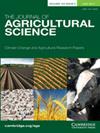Camu-Camu Flour Processed in Conventional Oven and Solar Dryer: Quality Product and Accessible Low Technology Products as an Opportunity to Family Agriculture
IF 1.7
4区 农林科学
Q2 AGRICULTURE, MULTIDISCIPLINARY
引用次数: 0
Abstract
The culture of camu-camu fruit is one of the most promising in the Amazon region; with proper industrialization the fruit could contribute to local food security, which raises excellent opportunities to further elaborate products with higher aggregate value to introduce to population living in natural producing areas. The aim of this research was to carry out a comparison of the agro-industrial and nutritional quality of fruit flour prototypes and residues from the processing of camu-camu dehydrated in a conventional electric oven and an alternative solar dryer, verifying the possibility of obtaining a standardized flour product with the techniques used. The camu-camu fruits was harvested in March of 2018 at Morena Lake, Boa Vista municipality, Roraima State, Brazil and, processed into flour at Embrapa Laboratories. Furthermore, an analysis of moisture, soluble solids, titratable acidity, pH, color and N, P, K, Ca, Mg, S, Cu, Zn, Mn, Fe and B contents of the flour, were carried out and evaluated. The experimental design was completely randomized in a factorial scheme, evaluating three raw materials by two drying methods. The data was statistically validated using an analysis of variance, when there was statistical difference, the means of agroindustrial and elemental characteristics were compared by the T (0.05) and Tukey (0.05) tests. The main quality differences in the interaction between raw materials and drying methods are in moisture, soluble solids, titratable acidity, color and P, K and Ca contents. In general, the macro and microelement contents of the camu-camu flour dehydrated in a hot air oven with forced ventilation, and in a low-cost convection solar dehydrator presented the following order N > K > P > Ca > S > Mg > Mn > Fe > B > Zn > Cu. The evaluated camu-camu flours are presented as alternatives for the integral use of the fruit and processing residues, having satisfactory qualities, with the possibility of being used in agro-industrial products.传统烤箱和太阳能烘干机加工的Camu-Camu面粉:优质产品和可获得的低技术产品为家庭农业提供了机会
camu-camu果实栽培是亚马逊地区最有前途的栽培之一;通过适当的工业化,这种水果可以为当地的粮食安全做出贡献,这就为进一步制作更高总价值的产品,向生活在自然产区的人们介绍提供了极好的机会。本研究的目的是比较在传统电烤箱和替代太阳能烘干机中脱水的camu-camu加工过程中产生的水果面粉原型和残留物的农工和营养质量,验证使用所使用的技术获得标准化面粉产品的可能性。camu-camu果实于2018年3月在巴西罗莱马州博阿维斯塔市的莫雷纳湖收获,并在Embrapa实验室加工成面粉。此外,还对面粉的水分、可溶性固形物、可滴定酸度、pH、颜色以及N、P、K、Ca、Mg、S、Cu、Zn、Mn、Fe和B含量进行了分析和评价。试验设计采用全随机因子设计,采用两种干燥方法对三种原料进行评价。采用方差分析对数据进行统计学验证,当存在统计学差异时,采用T(0.05)检验和Tukey(0.05)检验比较农工特征均值和要素特征均值。原料和干燥方法之间相互作用的主要质量差异在于水分、可溶性固形物、可滴定酸度、颜色和P、K、Ca含量。总体而言,在强制通风的热风烘箱和低成本对流太阳能脱水机中脱水的卡姆-卡姆面粉的常量元素和微量元素含量依次为N > K > P > Ca > S > Mg > Mn > Fe > B > Zn > Cu。经评估的camu-camu面粉作为水果和加工残留物综合利用的替代品,具有令人满意的质量,有可能用于农工产品。
本文章由计算机程序翻译,如有差异,请以英文原文为准。
求助全文
约1分钟内获得全文
求助全文
来源期刊

Journal of Agricultural Science
农林科学-农业综合
CiteScore
2.80
自引率
5.00%
发文量
68
审稿时长
1.4 months
期刊介绍:
The Journal of Agricultural Science publishes papers concerned with the advance of agriculture and the use of land resources throughout the world. It publishes original scientific work related to strategic and applied studies in all aspects of agricultural science and exploited species, as well as reviews of scientific topics of current agricultural relevance. Specific topics of interest include (but are not confined to): all aspects of crop and animal physiology, modelling of crop and animal systems, the scientific underpinning of agronomy and husbandry, animal welfare and behaviour, soil science, plant and animal product quality, plant and animal nutrition, engineering solutions, decision support systems, land use, environmental impacts of agriculture and forestry, impacts of climate change, rural biodiversity, experimental design and statistical analysis, and the application of new analytical and study methods (including genetic diversity and molecular biology approaches). The journal also publishes book reviews and letters. Occasional themed issues are published which have recently included centenary reviews, wheat papers and modelling animal systems.
 求助内容:
求助内容: 应助结果提醒方式:
应助结果提醒方式:


